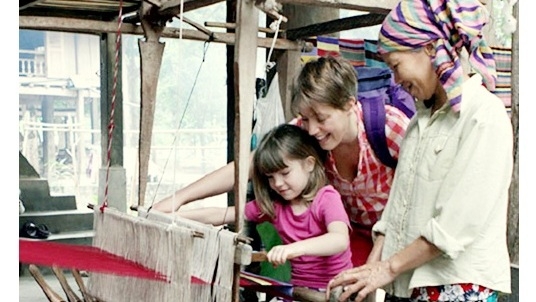After more than ten years since implementation of the 2005 Tourism Law, the new 2017 Tourism Law has been officially approved with a range of new points, aiming at promoting tourism development and turning it into a spearhead economic sector.

Foreign tourists try to join brocade weaving by Thai ethnic people in Lac hamlet, Mai Chau district, in northern Hoa Binh province. (Credit: VNA/Nguyen Thuy)
One of the new features of the newly-approved law is that the State will facilitate the involvement of local communities in tourism development.
This will be the basis for the development of community-based tourism, not only promoting the strength of indigenous culture but also helping stabilise local people's lives.
In recent years, community-based tourism has witnessed a relatively strong development with rich forms. There are many locales building successful models, such as Hoa Binh, Quang Ninh, Ha Giang, Lao Cai and Vinh Phuc provinces.
Specifically, community-based tourism activities in Lac hamlet (Mai Chau, Hoa Binh) have been developing quite strong, with an average of 30,000-40,000 visitors arriving per year.
With its stunning scenery, rich culture and diverse cuisine, the community tourism model in Den hamlet, Sa Pa, Lao Cai province also welcomes from 30,000-35,000 visitors per year, with annual revenue reaching from VND3-4 billion. Local households running homestay services net an additional average income of VND1-3 million per month.
Community-based tourism development mainly focuses on exploiting each locality's unique characteristics and mobilising the involvement of local communities in creating tourism products through which visitors can experience the daily life of local communities and enjoy the special indigenous cultural values.
This model helps enhance and encourage the participation of local communities in tourism activities so as to help visitors gain more knowledge about the culture, environment, customs and lifestyles of local people.

Abundant produce of local ethnic minorities in Tri Nang commune, Lang Chanh district, Thanh Hoa province, attracts visitors. (Credit: NDO)
In addition to promoting the beauty of indigenous culture, the biggest gain of community tourism is the improved life of local people themselves.
Although the development of community-based tourism products is consistent with the common trend and the number of visitors seeking these tourist products is increasing, in fact, community-based tourism in Vietnam is still spontaneous and has not improved much yet.
Mostly, community-based tourism is in the form of sightseeing and has not achieved the purpose of raising awareness, environmental education and enjoying special characteristics in the indigenous culture of local communities for visitors.
Several localities still focus much on economic benefits, leading to a too hot development of scattered travel services without sustaining tourism activities.
For that reason, the most important thing to ensure the development of community-based tourism, is that local communities must be deeply aware of their unique values and culture, and then transmitting to visitors such values by love, respect and belief.
Together with the removal of obstacles that are hindering community tourism, experts should coordinate in researching and guiding indigenous people to build attractive and non-duplicative products, thus ensuring preservation of landscape and the environment and avoiding destroying typical characteristics of indigenous culture.
In order to limit the spontaneous development of community-based tourism as at present, it is necessary to build concrete and clear planning, while strengthening the State management over tourism activities.
However, it should be noted that State management is not merely management or tightening but guiding and creating favourable conditions for people to properly and effectively realise this tourism model.
















